Graveyard-shift largemouths
Hot water and bright skies often push largemouths into nocturnal feeding patterns
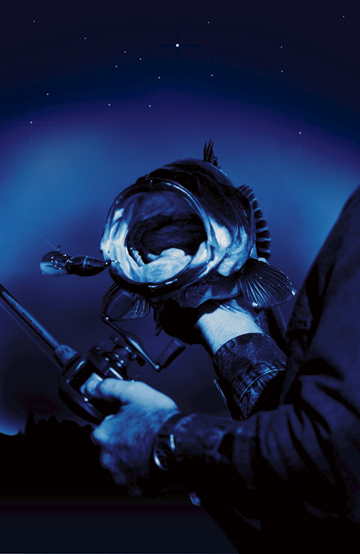
Sometimes when things go bump in the night, it’s a good thing. Take for instance, a pig of a largemouth bumping and slamming a Colorado-blade spinnerbait in the pitch dark. Or, the distinct tap-tap of a lunker inhaling a jig-and-pig combination and pummeling it with its crusher plates. These things make nightshift bassin’ worthwhile and exciting.
When the stifling heat and humidity of summer get the best of the daylight bite – with sunshine-laden, cloudless skies baking the surface temperature – seasoned bass experts rely on nighttime fishing to sack up a big bag of largemouths.
“Nighttime largemouth fishing in the middle of summer can be awesome,” said Cody Bird, a Yamaha pro from Granbury, Texas. “Bass are pressured much more during the daytime, and often they will feed heavily during the night, regardless of the moon phase. It’s another world at night.”
The Texan likes to fish the graveyard shift in his home state at Lake Fork – a Mecca for behemoth largemouths.
“It seems to take an hour or two after dark for bass to adapt to the light change,” he said. “I’ve won several night tournaments over the years, but the bite usually isn’t good until bass have adjusted. You can catch a limit in short order once they start biting, though.
“Even with hot surface temperatures, largemouths can get extremely shallow at night.”
On bodies of water unfamiliar to Bird, he’ll look for grass beds and concentrate on edges of grass lines. If no grass is present, he’ll opt for fishing riprap, reeds or boat docks. He believes largemouths cruise the edges of reeds when the moon comes up and the sun goes down.
Bird’s go-to lure is a jig-and-craw worm combination, although sometimes he’ll attach a chunk instead.
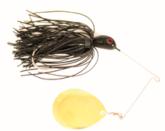 “I like to swim a black jig around docks or reeds at night,” Bird said. “Paralleling the cover with an up-and-down motion of the jig without having it ever hit the bottom works for me. I also throw a 1/2- or 3/4-ounce black spinnerbait with a big, gold Colorado blade. Lastly, I use a 3/8- or 1/2-ounce black buzzbait.”
“I like to swim a black jig around docks or reeds at night,” Bird said. “Paralleling the cover with an up-and-down motion of the jig without having it ever hit the bottom works for me. I also throw a 1/2- or 3/4-ounce black spinnerbait with a big, gold Colorado blade. Lastly, I use a 3/8- or 1/2-ounce black buzzbait.”
It’s common knowledge that largemouths hunker down in deeper water during blistering summer days. Bird’s experience tells him to fish close to productive daytime areas when happy hour begins for the mosquitoes.
“I prefer to have deep water close by since bass are spending the daytime hours in deeper water,” the affable 41-year-old said. “Largemouths go wherever they want at night. They’re a lot like white-tailed deer.”
Bird fishes clear and stained lakes at night, but he doesn’t have a preference. As for moon phases, he believes bass feed just as well under a bright moon or on a dark, calm night regardless of the phase.
“To me, the calmer nights are better,” he said. “In one night, a partner and I have caught as many as 15 or 20 bass over 4 pounds at Lake Fork. It can be phenomenal.”
On stained lakes, Bird relies on swimming the jig, and he’ll employ that technique along riprap.
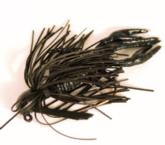 “When I fish the jig at night, I’m trying to imitate a bluegill,” he said. “I know bluegills aren’t black, but I think the swimming action resembles them well.”
“When I fish the jig at night, I’m trying to imitate a bluegill,” he said. “I know bluegills aren’t black, but I think the swimming action resembles them well.”
On clear lakes, Bird scores with the jig, too.
“I was on the hunt for a state-record smallmouth in Texas at Lake Whitney one summer night, and I caught an 8 3/4-pound largemouth on a black jig tipped with a craw worm in crystal-clear water,” Bird said. “I caught that fish along riprap underneath a bridge.
“A lot of times at night I’ll use 65-pound-test SpiderWire,” he said. “You can get away with heavier line at night, plus you really don’t know what you’re going to hook once the sun goes down. I’ve even gone as high as 80-pound SpiderWire when fishing buzzbaits. I fish buzzbaits at night with a slow, steady retrieve. If the fish wants it, he’s going to come and get it.”
Kellogg’s pro Alvin Shaw of State Road, N.C., also favors night-fishing in the summertime.
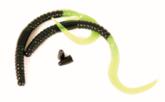 “My favorite night-fishing bait is a black, Texas-rigged worm with either a blue or chartreuse tail, on an 1/8- to 1/4-ounce sinker,” Shaw said. “I like to cast it around docks or to submerged rock piles. Riprap is also good. Since I’m doing everything by feel, I rely on a quality rod because sensitivity is so critical at night.”
“My favorite night-fishing bait is a black, Texas-rigged worm with either a blue or chartreuse tail, on an 1/8- to 1/4-ounce sinker,” Shaw said. “I like to cast it around docks or to submerged rock piles. Riprap is also good. Since I’m doing everything by feel, I rely on a quality rod because sensitivity is so critical at night.”
Shaw recommends drop-offs, too, and he reaches for a black spinnerbait or a black with blue flake Norman DD22. When he picks up his spinnerbait rod, Shaw steps out of the box by using a tandem willow-leaf model in lieu of traditional Colorado blades at night. He always uses black nickel or painted black blades. He methodically fishes the spinnerbait around docks or other cover, and he slow-rolls the blade along drop-offs or channel bends.
This Tar Heel will also fish a 5-inch, black with red flake tube, into which he inserts a rattle for added sound.
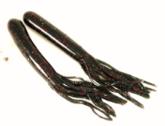 “There’s a whole lot of shaking going on when I fish the tube,” he said. “If they’re not hitting the worm, I reach for the tube and do lots of shaking, without moving it very far.”
“There’s a whole lot of shaking going on when I fish the tube,” he said. “If they’re not hitting the worm, I reach for the tube and do lots of shaking, without moving it very far.”
Shaw acknowledged that buzzbaits are the topwater lure of choice for most nighttime anglers, but he favors a black Jitterbug. His technique is to walk it slowly with intermittent pauses before resuming. These pauses in the tranquil nighttime calmness can oftentimes be interrupted by the sound of a giant largemouth engulfing the bait.
“Sometimes I’ll put a black rubber skirt on the rear treble hook of the Jitterbug for added profile,” he said.
Like Bird, Shaw doesn’t get wrapped around the axle regarding moon phases, but if he had to pick one, he’d favor a new moon.
“The darker the better, especially in August,” he said. “I think the dark nights of August are the best for nighttime bass fishing.”
Shaw favors clear water for night-fishing and believes fish will be much shallower if the water is stained. In clear lakes, Shaw generally fishes much deeper; however, he feels the topwater bite can be phenomenal in clear water, too.
He recommends anglers launch before dark so they can run to their favorite spot before nightfall. He’ll only get his Ranger 520VX on plane if he has plenty of moonlight to see. He’s also an advocate of using a quiet trolling motor at night.
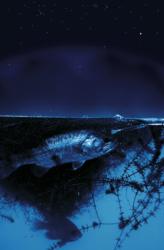 “I think a quiet trolling motor is essential at night since largemouths are keying on your baits by vibrations they pick up with their lateral lines,” he said. “I rely on my Minn Kota 101 to sneak up on unsuspecting bass.
“I think a quiet trolling motor is essential at night since largemouths are keying on your baits by vibrations they pick up with their lateral lines,” he said. “I rely on my Minn Kota 101 to sneak up on unsuspecting bass.
“The night-bite is at its best when fishing pressure and boating traffic are heavy during the day,” he said. “On those nights, the fishing can be great – bass start to really become nocturnal feeders.”
If you’re in a swivet over tough daytime outings, consider the dark side. Instead of taking the day off from work, try taking the night off from sleep – it might be the best move you make all summer long.
Black as night
When it comes to lure color for night-fishing, most pros agree that black is where it’s at.
“I think black lures silhouette better, particularly if the moon is out,” said Yamaha pro Cody Bird. “The profile of a black bait really shows up against the night sky.”
“Dark colors on dark nights have been the best for me,” Kellogg’s pro Alvin Shaw said.
Bass feed heavily by using their lateral lines at night, and not as much with their sense of sight, although life underneath the water’s surface is more visual than one may think, particularly if the moon is out. Good choices are lures that create vibrations and send sound waves to alert bass with gaping mouths that a midnight snack is served.
Bug out
Although night-fishing allows anglers to escape the heat, it comes with its own set of concerns. Anglers may wish to consider donning their lifejackets the entire night – not just when under power. Always bring backup batteries for flashlights. Lastly, don’t forget the bug repellent, or it may be your last night-fishing trip! Practice safety and be mindful of your surroundings at all times.